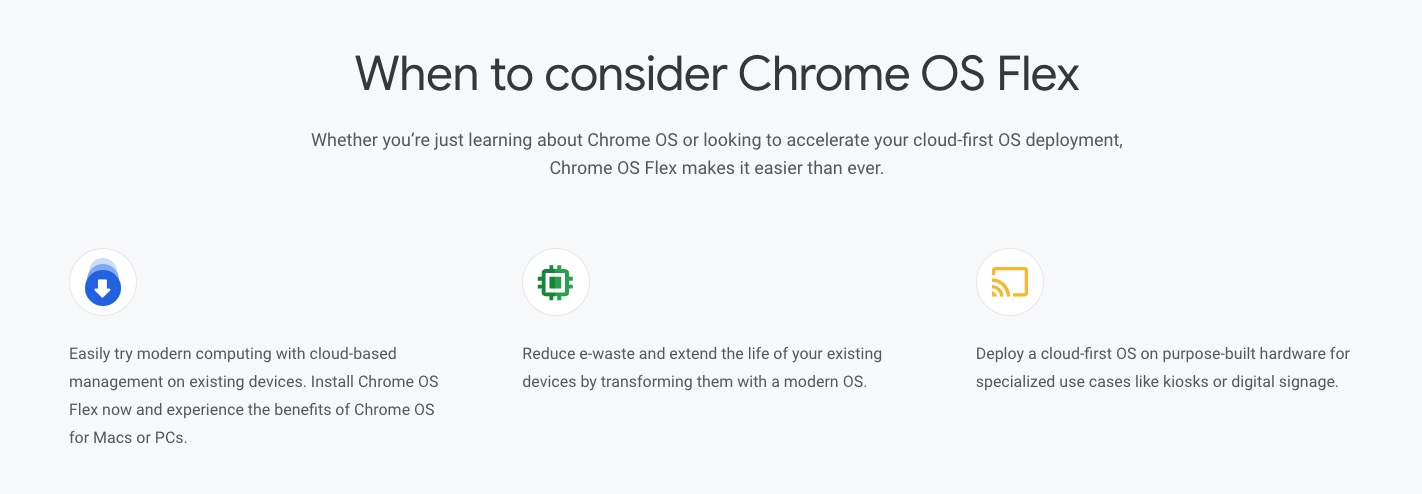
Google Revisiting Digital Signage With “Flex” Chrome OS That Runs On PCs And Macs
February 21, 2022 by Dave Haynes
Google has kinda sorta a little got back into the digital signage and interactive display business – having announced an evolution of the Chrome operating system that can now run on new and existing Windows and Mac devices.
Previously, using Chrome OS was limited to dedicated hardware like the Chromeboxes, all-in-one screens and even sticks a small set of manufacturers were putting out.
The pitch for Chrome OS Flex is that it makes PCs and Macs secure, fast, auto-updated and managed from the cloud. Devices, and now not just ones with Chrome in the name, are all managed via the Chrome device management console.
Google has been working on this for a while now, I am told, notably with some digital signage software companies that have been using Chrome on commercial jobs.
Those who have been around digital signage for many years will recall the tech behemoth made a big splash in the digital signage ecosystem by taking out a big, can’t miss booth at the old Digital Signage Expo in 2015. It highlighted a pile of partner software companies and had observers suggesting either:
- Google will crush everyone and take over signage;
- Google will be just like other tech giants like Cisco and lose interest quickly.
I don’t have formal insight on decision-making, but it was pretty clear Google lost interest. There was way more opportunity for scale in areas like education than retail signage. I knew several people at Google back in 2016-17 involved in signage, but couldn’t give you a name now. It also appeared Chrome and Android, both developed and supportedby Google, were converging. and Android is now widely accepted and used for signage applications.
While Google went quiet on signage, there are a handful of CMS companies that have continued to use Chrome OS and Chrome devices – notably Australia’s Stratos Media, UK-based ScreenCloud, Israel’s Novisign and Canada’s Rise Vision and Telemetry TV. I assume I am missing some, but these ones spring to mind … sorry!!!
What they like are the bulletproof, cloud-managed nature of the boxes and secure cloud platform. Chrome device pricing has also been attractive, though there are less costly hardware options out there.
The introduction of Flex is interesting because it is kind of like a variation on what the Czech firm SignageOS does. That firm offers middleware that makes it possible to run blended networks of different system-on-chip smart devices and players. In the case of Chrome OS Flex, it makes it possible to run a blended network of devices and possibly lower capital and operating costs.
For example, if a school district network has some digital sign endpoints already, that run off PCs, and it wanted to standardize on Chrome OS because the IT team already manages a pile of Chromebooks issued to students, it previously would have had to decommission those PCs and replace them with dedicated Chrome hardware. With Flex, they can be loaded with Chrome OS just using a USB drive, and re-purposed at no additional capital cost. Google is certifying a range of existing PCs, I am told, and also working with manufacturers on new Chrome units.
Google also highlights on its landing page for Flex: Deploy a cloud-first OS on purpose-built hardware for specialized use cases like kiosks or digital signage.
The Flex license is free and I assume Google and its resellers make money though the management software.
The German firm Invidis has an interesting take on this development, including the observation that the real interest with this – for Google – is with the business data generated by activity.



Makes sense for Google to go after the PC and Mac market and look to switch those to ChromeOS under the Flex (Neverware) offering.
We have a good few thousand ChromOS devices connected to Signagelive and they work exceptionally well and are very reliable.
The challenge has always been that those in the Google ChromeOS ecosystem are not used to (or wish to) provide the on-site services and associated products required to deliver digital signage solutions.
In addition, those AV resellers keen to sell ChromeOS solutions are put off by the need to set up and manage devices via Chrome’s Enterprise Management Portal.
There are, however, some resellers who have really embraced ChromeOS and added Google’s device management APIs into their own portal alongside their chosen CMS to create a unified and transparent experience for customers.